Do you want to set up email logs on your WordPress or WooCommerce website?
Email logs allow you to monitor the emails sent by your WordPress site to the users. This helps you troubleshoot issues and check the status of email notifications sent by your WordPress website.
In this article, we will show you how to easily set up WordPress email logs and WooCommerce email logs.
After following this tutorial, you’ll be able to view the email logs directly from your WordPress admin area in an easy to understand format.

Why Set Up Email Logs in WordPress or WooCommerce?
Whether you are running a small business website using WordPress or a WooCommerce store, WordPress automatically sends certain email notifications to your users.
On a typical WordPress website, these emails include password reset emails, new user notification, password change notification, comments, and WordPress update notifications.
If you are also running an online store, then email becomes even more important. WooCommerce will send out customer receipts, order details, new order notifications, and user account emails on a regular basis.
As you can see, email notifications are crucial for your website to function properly and deliver the best user experience.
You need to make sure that those emails reach users’ inbox and don’t just disappear or end up in spam.
The best way to do this is by using a proper SMTP service provider to ensure email deliverability. For more details, see our guide on how to fix WordPress not sending email issue.
You would also want to see which emails are sent and to whom. This allows you to keep a record of email activity which comes in handy in several situations.
Following are just a few of those situations when email log comes in handy:
- Ensure that email notifications are delivered promptly
- Track your WordPress contact form plugin emails
- You can see if emails sent by a plugin are working
- Keep a track of user activity using the email logs
- Track user activity if you run a membership website or sell online courses
- Keep email log of your WooCommerce orders, reciepts, and customer notifications
That being said, let’s see how to easily setup email logs on your WordPress or WooCommerce website.
Setting up Email Logs in WordPress & WooCommerce
For this tutorial, we will be using the WP Mail SMTP plugin. It allows you to send WordPress emails using any SMTP service provider including Gmail, Outlook, SendGrid, Amazon SES, etc.
Step 1. Install and Setup WP Mail SMTP
The first thing you need to do is install and activate the WP Mail SMTP plugin. For more details, see our step by step guide on how to install a WordPress plugin.
Upon activation, you need to visit WP Mail SMTP » Settings page to configure the plugin settings.
First, you’ll need to enter your license key. You can find this information under your account on WP Mail SMTP website.
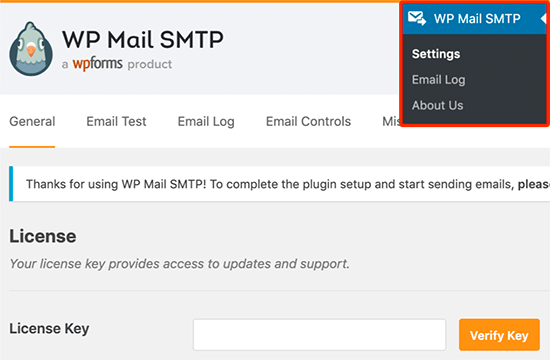
Simply, copy and paste your license key and then click on the Verify button.
After that, you need to scroll down to select how you would like to send your WordPress emails under the Mailer section.
WP Mail SMTP works with any SMTP service. It comes with easy configuration options for the most popular SMTP service providers like Gmail, Outlook, Sendinblue, Mailgun, Sendgrid, Amazon SES, or Other SMTP services.
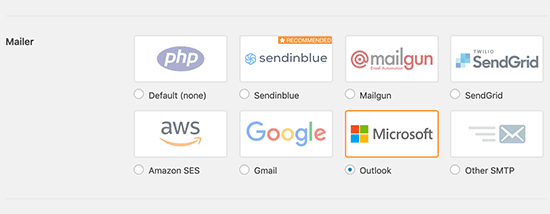
Clicking on the mailer will show you instructions to set it up.
The default option is set to PHP mailer. We don’t recommend using that because it is not reliable. Since most WordPress hosting servers are not properly configured for emails, this option will mean that your WordPress emails may never reach users’ inbox or even spam folder.
We recommend using a provider like SendinBlue or Mailgun that’s optimized for best email deliverability.
If you choose Other SMTP as your mailer option, then you’ll need to provide SMTP settings which you can get from your SMTP service providers website.
- SMTP Host: You smtp host address which usually looks like this smtp.yoursmtpserver.com
- Encryption: Usually it is either SSL or TLS
- SMTP Port: Usually it is 465
- Authentication: Turn on authentication
- Username: Username provided by your SMTP service usually it is your email address.
- Password: Password for your SMTP service
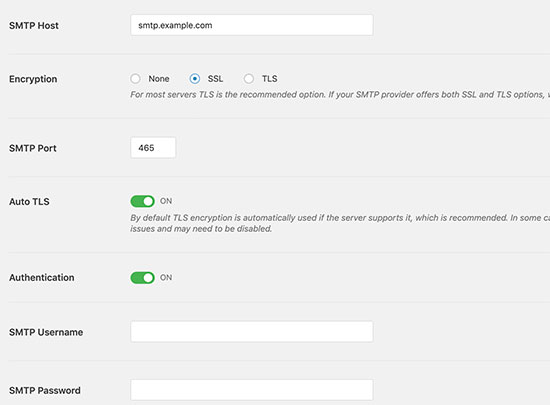
After you have entered your mailer credentials, don’t forget to click on the ‘Save Settings’ button to store your settings.
Bonus: It’s important to use a professional business email address to ensure your emails look trustworthy.
Step 2. Enable Email Log Feature
Now that you have set up mailer settings in the WP Mail SMTP plugin. It is time to turn on the email logging feature.
From the plugin’s settings page, switch to the ‘Email Log’ tab and check the box next to ‘Enable log’ option.
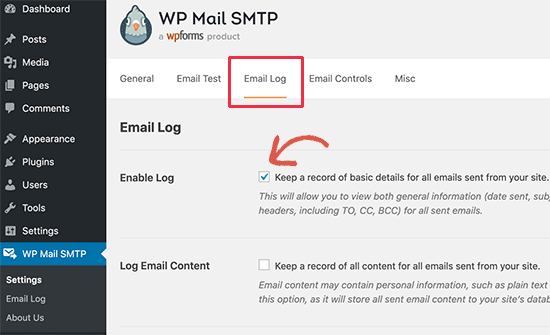
The email log option will save general and troubleshooting information about each email message. Including the date and time, subject, email status, email addresses of the sender and recipient, BCC and CC, attachment, etc.
The plugin also allows you to enable complete WordPress email logs. We don’t recommend enabling complete email logs because it would save all contents of the email including private or sensitive information in your WordPress database as plain text.
Don’t forget to click on the ‘Save settings’ button to save your changes.
Step 3. Testing WP Mail SMTP Setup
Now that you have set up the WP Mail SMTP plugin, let’s test it to make sure that everything is working as expected.
WP Mail SMTP makes this step easy. Go to the plugins settings page WP Mail SMTP » Settings page and switch to the ‘Email Test’ tab.
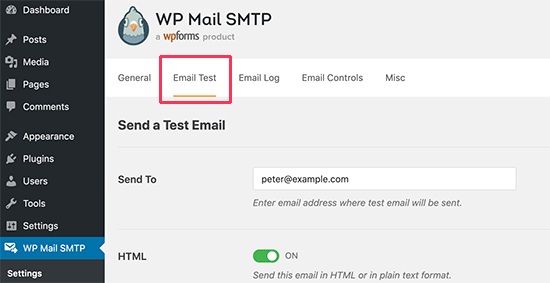
From here, simply enter your email address and click on the ‘Send Email’ button.
The plugin will now send a test email to the address you provided. It will then show you the status of the email delivery on screen.
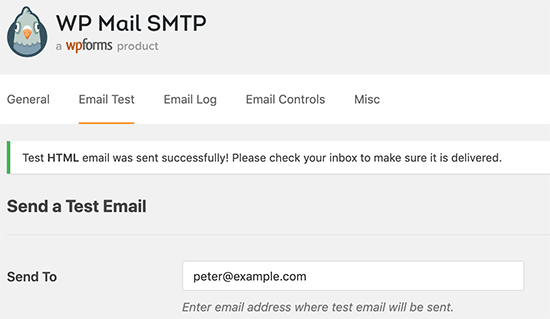
Step 4. Viewing Your Email Logs in WordPress
You can view your WordPress email logs at any time without leaving the WordPress admin area.
Simply go to WP Mail SMTP » Email Log page. You’ll see the log with a list of entries since you enabled the email log.
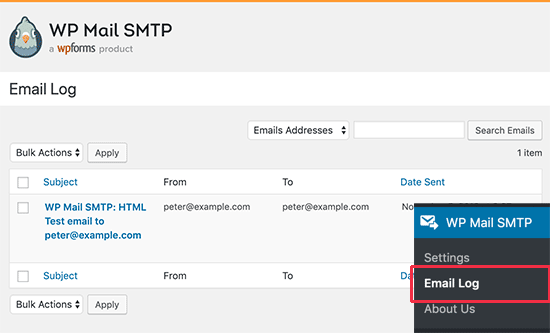
To view entry details, take your mouse over it and then click on the ‘View’ link below it. This will open the email log entry with a detailed view.
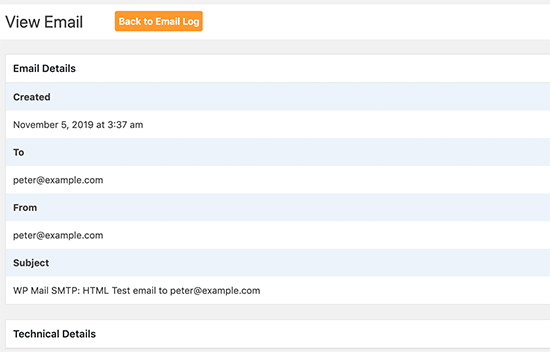
You can also use the search feature to look for entries by email address, subject & headers, or by content (if you enabled content logging).
You can also delete older entries from your email log. You can use the ‘Delete’ link below any entry to delete a single entry.
You can also select multiple entries and click on the Bulk Actions drop-down menu to select ‘Delete’ and then click on the Apply button.
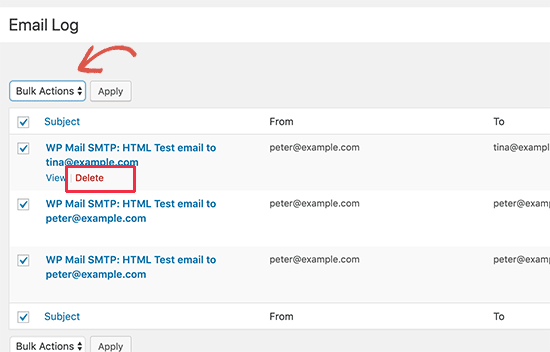
We hope this article helped you learn how to set up WordPress email logs and WooCommerce email logs. You may also want to see our guide on how to monitor user activity in WordPress with security audit logs.
If you liked this article, then please subscribe to our YouTube Channel for WordPress video tutorials. You can also find us on Twitter and Facebook.
The post How to Setup WordPress Email Logs (and WooCommerce Email Logs) appeared first on WPBeginner.

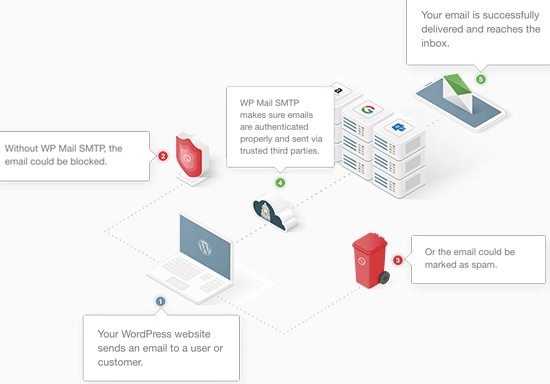
No comments:
Post a Comment